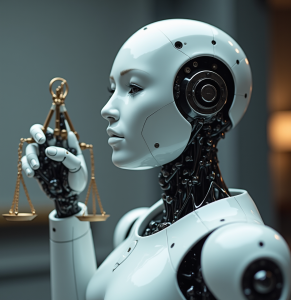
Artificial Intelligence (AI) refers to engineered technology designed to perform tasks that simulate human cognitive functions, such as problem-solving, reasoning, learning, and perception. However, when discussing AI, special attention must be given to its role in intellectual property (IP) rights and legal frameworks.
An AI system utilizes algorithms and data to process information and make informed decisions. Broadly, AI can be categorized into two main types:
Weak AI systems are developed for specific tasks and typically lack the capacity for self-improvement or enhanced efficiency. Examples include virtual assistants like Siri and Alexa.
Theoretically, this type of AI is capable of performing and analyzing any task that a human can undertake. General AI is also the major focus of current discussions on AI development.
The notion—whether considered a delusion, a nightmare, or even an impending reality—that advancements in AI could harm human society or potentially lead to humanity’s extinction has prompted a plethora of research and articles. However, the reality of AI today, including its applications, presents considerably more pressing legal, social, and ethical issues than fictional scenarios or cinematic storytelling.
While AI, especially generative AI, is rapidly advancing and optimizing its applications across various aspects of human life, it is not without its own flaws and challenges. Beyond mere operational limitations, AI presents numerous legal and ethical questions, particularly in content creation. Below, some of these challenges are outlined:
AI-driven systems often require extensive access to a wide range of personal, governmental, and academic data. This reliance has transformed privacy protection and confidentiality into pressing legal challenges within the digital landscape.
Current laws and frameworks, like the European Union’s General Data Protection Regulation (GDPR), impose strict requirements regarding data management, such as conducting data protection impact assessments (DPIAs) for AI systems that process users’ personal information.
For example, Italy’s data regulator issued an emergency ruling in March 2021 after discovering that OpenAI’s ChatGPT was processing personal user data without an adequate legal basis, temporarily halting access to such data. Similarly, the European Parliament and Council of Europe have sought regulations that require AI governance alignment with data protection agencies like the EDPB-EDPS. Enforcement measures have also targeted private companies, such as social media platforms and cloud service providers, which process large volumes of personal data with questionable transparency.
AI systems can sometimes exhibit biased behaviors or generate flawed outcomes, creating ethical and legal complications. For instance:
In 2015, Google Photos labeled two African-American individuals as “gorillas” using facial recognition technology.
In 2018, Amazon abandoned its AI recruitment tool, which was found to discriminate against resumes containing the term “women,” systematically favoring male candidates.
Such incidents highlight the ethical and legal risks of AI algorithms and underscore the urgency for AI regulation and the vigilant engagement of its users.
The intersection of artificial intelligence and intellectual property is a controversial area, particularly when AI is involved in creating content, artworks, or inventions. Key IPR-related challenges include the following:
For example, in a case involving Juventus Football Club and Blockers, the Court of First Instance in Rome ruled in favor of Juventus. The court stated that Blockers, despite having a legal contract with a former Juventus player (Christian Vireo), could not exploit the player’s likeness in Juventus attire for the creation and sale of NFTs. This decision emphasizes how reproducing registered trademarks in the digital domain—even through AI—is subject to strict legal and financial liabilities.
One of the most contentious topics in this field is determining ownership of AI-generated content. Traditionally, copyright applies only to works created by humans or their legal representatives. For AI-generated works, the rights often belong to the individual or entity operating the AI system. However, the legal framework around this issue remains unclear.
For instance:
If AI uses copyrighted material without authorization to create new works, the question arises as to who bears responsibility for potential copyright violations: the AI developer, its user, or both?
Additionally, the concept of “originality” is central to copyright protections. It remains an open question as to what qualifies as “original” in the context of AI-generated outputs, particularly if they are derived from preexisting human works.
AI-generated inventions must meet requirements of novelty, inventiveness, and industrial applicability to be patentable. As with copyright, determining ownership of such inventions can be challenging, especially when the AI system is managed by an organization.
With the intensification of intellectual property enforcement in Iran, particularly in cultural and artistic domains, the growing utilization of AI systems creates both opportunities and risks for users. The extent to which AI technologies are employed wisely and responsibly determines the balance between efficiency and potential legal entanglements.
The pressing need for updated regulations, responsible AI usage, and consumer mindfulness in selecting expert AI service providers cannot be overstated. Legislative bodies must continue formulating adaptive frameworks to regulate AI efficiently, while users must exercise caution in navigating the legal and ethical dimensions of this revolutionary technology.